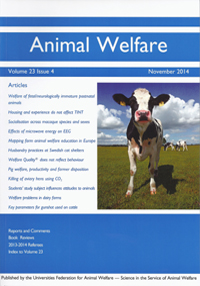Document type : Scientific article published in Animal Welfare
Auteurs : L. Frondelius, Jauhiainen, O. Niskanen, M. Mughal, A. Sairanen
Preview: The aim of this study was to investigate factors responsible for between-herd variation in milk production, when genetic variation is controlled. Quantitative information regarding farms' production environment and animal welfare, as evaluated annually by veterinarians and health and feeding records, were the factors studied. Principal component analysis was used to reduce the production environment variables as well as the welfare data. Two linear regression models were devised. The first model used welfare indicators and veterinary treatments to predict the difference between herds' observed and potential milk yield. The second model explained the residual of the first model by feeding and animal-based indicator data. Together, these two models explained 62% of the variance in milk yield differences between herds. Specifically, feeding of the herd was the most important factor, accounting for 67%, followed by the production environment/animal welfare (30%) and finally animal health, assessed through veterinary treatments, explained the remaining 3% of the variance. A poor welfare rating adversely affected milk production. Similarly, a low score for fatness at slaughter, poor milk quality and high mortality all showed a clear negative association with production. It was found that while feeding remains a major factor, production environment and animal welfare also have significant roles to play when it comes to production. Notably, those farms with major animal welfare problems were shown to display milk yield below the Finnish average.



